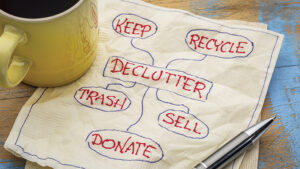Does this spark joy?” I asked myself. Cradling an apple spice candle in my hand, I sniffed the top of it.
The scent is gone probably from sitting in the attic for 15 years, I thought. It definitely isn’t sparking any joy. I tossed it in the overflowing trash pile.
The Life-Changing Magic of Tidying Up, a book by Marie Kondo, had been a best seller for 86 weeks when I first discovered it. That discovery prompted a month-long marathon decluttering of my house. I emptied every drawer, closet and bin which resulted in eleven bags for donation and ten for the garbage.
I consider myself a “neat freak,” yet if I wrote a book how I “clean up,” it would end up in the clearance bin. My three children get annoyed with my “neat freak” ways. When they’re eating a meal, I’m right there wiping away the crumbs. Labeled bins hold their toys, clothes, or sports gear. If they don’t put their things in the proper place, they going to deal with my wrath.
When I first heard of this book, I couldn’t figure out how she sold so many copies of a book about the least exciting topic I can think of. But as I read her book, I hung on every word. It was more captivating than the psychological thrillers I usually read. The deeper I delved, the clearer the central theme of the book became – to have the reader analyze their relationship to material items.
In the book Kondo states, “Putting things away creates the illusion that the clutter problem has been solved.” Even though everything I own is neatly stacked or stored in a bin, I rarely get rid of things. Like Kondo says, I was under the delusion I was living a clutter-free life.
“You will never use spare buttons,” Kondo states. She’s right – I’ve never sewed a button on a shirt in my life, so why did I have a pile of buttons in my drawer? I could no longer ignore the clutter.
“If you see an (electrical or cable) cord and wonder what on earth it’s for, chances are you’ll never use it again,” Kondo states. When I looked at the bag of unidentified cords I owned, I realized I had not used any of cords since I created the collection.
The book got me to think about how I acquired each object I owned and why I held on to it. I realized that there was a pattern to why I kept items. I worried I might need it in the future or felt guilty about never using it.
It was time for me to initiate step one in her book: “start discarding, all at once, intensely and completely.” This process should focus on “what we want to keep, not what we want to get rid of.” She suggests you do this by holding each item you own and ask yourself, “Does this spark joy?” At first this question seemed ridiculous to me, but I tried it despite my misgivings.
“If you only keep the items which spark joy, then you surround yourself with things that make you happy,” Kondo says. This reorganization of your material things can lead to a transformation in your life and perception.
For me, the biggest transformation came through discarding my unused items and unworn clothing. Kondo refers to this as “the magic effect of tidying.”
She recommends saying to yourself, “Thank you for teaching me what doesn’t suit me.” This simple reframing thought process helped me to take my unworn red shirt with the tags on it and place it in the donation pile.
Kondo says when you are done tidying, “You can see quite clearly what you need in your life and what don’t, and what you should and shouldn’t do.”
She says it will increase your confidence since the process involves making decisions about whether to keep items. You are also forced to confront decisions you made in selecting your possessions and to hopefully learn from poor decisions.
When I finished tidying, I felt a sense of accomplishment. Opening a drawer and finding a pen without any useless buttons, gave me pride in my ability to get rid of unnecessary things. I experienced a life transformation as well. In the fourth grade I wrote my first book which my teacher typed using a typewriter and a cloth to create a cover. I found this book while cleaning. It was a reminder of my love for writing which I had dabbled in throughout the years.
Once I “cleaned house” I decided to actively pursue freelance writing which has led to publishing my writing in publications such as The New York Times, Parents Magazine, Chicken Soup for the Soul, Upworthy, Twins Magazine and other publications.
Being a stay-at-home mom can feel isolating. Writing has allowed me to meet other people and feel connected to them. Like Kondo says, I put my space in order, in a way that changed my life forever.
Cheryl Maguire holds a master’s degree in counseling psychology. She is married and is the mother of twins and a daughter. Her writing has been published in The New York Times, Parents Magazine, National Geographic, and Your Teen Magazine. You can find her at Twitter @CherylMaguire05





